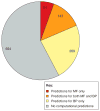Functional annotations for the Saccharomyces cerevisiae genome: the knowns and the known unknowns
- PMID: 19577472
- PMCID: PMC3057094
- DOI: 10.1016/j.tim.2009.04.005
Functional annotations for the Saccharomyces cerevisiae genome: the knowns and the known unknowns
Abstract
The quest to characterize each of the genes of the yeast Saccharomyces cerevisiae has propelled the development and application of novel high-throughput (HTP) experimental techniques. To handle the enormous amount of information generated by these techniques, new bioinformatics tools and resources are needed. Gene Ontology (GO) annotations curated by the Saccharomyces Genome Database (SGD) have facilitated the development of algorithms that analyze HTP data and help predict functions for poorly characterized genes in S. cerevisiae and other organisms. Here, we describe how published results are incorporated into GO annotations at SGD and why researchers can benefit from using these resources wisely to analyze their HTP data and predict gene functions.
Figures



References
-
- Goffeau A, et al. Life with 6000 genes. Science. 1996;274:563–567. - PubMed
-
- Jones GM, et al. A systematic library for comprehensive overexpression screens in Saccharomyces cerevisiae. Nat Methods. 2008;5:239–241. - PubMed
-
- Huh WK, et al. Global analysis of protein localization in budding yeast. Nature. 2003;425:686–691. - PubMed
-
- Winzeler EA, et al. Functional characterization of the S. cerevisiae genome by gene deletion and parallel analysis. Science. 1999;285:901–906. - PubMed
-
- DeRisi JL, et al. Exploring the metabolic and genetic control of gene expression on a genomic scale. Science. 1997;278:680–686. - PubMed
Publication types
MeSH terms
Substances
Grants and funding
LinkOut - more resources
Full Text Sources
Molecular Biology Databases

